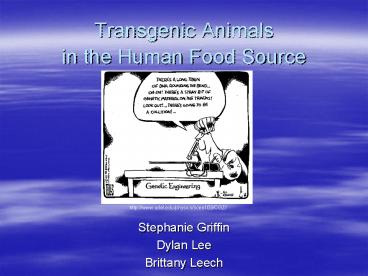Transgenic Animals in the Human Food Source - PowerPoint PPT Presentation
1 / 20
Title:
Transgenic Animals in the Human Food Source
Description:
Transgenic Animals. in the Human Food Source. Stephanie Griffin. Dylan Lee. Brittany Leech ... At least 30 aquatic species. Flounder Carp. Lobster Shrimp. Farm ... – PowerPoint PPT presentation
Number of Views:141
Avg rating:3.0/5.0
Title: Transgenic Animals in the Human Food Source
1
Transgenic Animals in the Human Food Source
http//www.udel.edu/physics/scen103/CGZ/
- Stephanie Griffin
- Dylan Lee
- Brittany Leech
2
Menu
Appetizers Spiced Potatoes with Waxmoth
genes Juice of Tomatoes with Flounder
genes Entrée Blackened Catfish with Trout
geneScalloped Potatoes with Chicken
geneCornbread with Firefly gene Dessert Rice
Pudding with Pea gene Beverage Milk from Bovine
Growth Hormone (BGH)Supplemented
Cows http//www.woodrow.org/teachers/bi/1992/tran
sgenic_food.html
3
Definition
- Genetically engineered animals or transgenic
animals are those that have had DNA from a
foreign animal inserted into their genome. The
new DNA from other organism may come from plants,
other animals or even bacteria.
4
Background
- With the hope for creating better food
supply scientists started fiddling with the
genetic makeup of animals that were being used in
the food source system. Animals cattle, fish,
poultry, and swine in particular were injected
with gene material from other organisms. The new
DNA would join onto the animals DNA and form a
new sequences in the gene pattern. With the new
genes, milk is able to be less fatty, milk can
contain anti-bacterial properties, fish can grow
faster creating more supply to fulfil the demands
of growing societies.
5
Creating A New Variety of Fish The Technique to
Make Transgenic Animals
- Breeders can now use the tools of biotechnology
to introduce new characteristics into animals.
For example, researchers have figured out how to
give a type of salmon a gene that directs the
production of a growth hormone, causing the fish
to grow to full size in substantially less time.
Here is an outline of the steps needed to
introduce the new growth hormone gene into the
salmon. - Scientists duplicate the DNA carrying the genetic
information for the growth hormone. - The gene is inserted into a circular piece of DNA
called a plasmid that can be reproduced inside
bacteria. - Next, the plasmids go inside the bacteria.
- When the bacteria grow in the laboratory, they
produce billions of copies of the plasmid
carrying the growth hormone gene.
6
- After the copies of the plasmid carrying the
growth hormone gene have been produced, they are
isolated from the bacteria. The plasmid is then
genetically edited, changing its circular
structure into a linear bit of DNA. The linear
DNA is sometimes called a gene cassette because
it contains several sets of genetic material in
addition to the growth hormone gene. - The gene cassette is either directly injected or
mixed with fertilized fish eggs in such a way
that the eggs absorb the DNA, making the cassette
a permanent part of the fish's genetic makeup.
Since scientists insert the growth hormone gene
into the fish's egg, the gene will be present in
every cell in the fish's body. - The eggs are allowed to hatch, producing a school
of fish in which some are genetically changed and
others are not. - Fish that now carry the growth hormone gene are
identified. Fish with the properly integrated
gene are used to create a breeding stock of the
new, faster-growing variety. - --C.L.
- http//www.fda.gov/fdac/features/2001/101_fish.htm
l
7
http//www.bio.miami.edu/dana/250/25003_10.html
8
http//www.biologymad.com/master.html?http//www.b
iologymad.com/GeneticEngineering/GeneticEngineerin
g.htm
9
Animals that have been GE
- At least 30 aquatic species
- Flounder Carp
- Lobster Shrimp
Farm Use Pigs Chickens Cows
Human Research Lab rats Mice Rabbits Monkeys
10
Past Experiments
- Removing the allergen gene Cats
- Spiders Goat milk Goats
- Jellyfish genes Art Rabbits
11
Current Endeavors
- Flounder genes salmon Super Salmon
- Goats milk blood clotting
- Knock out mice
- Glowing fish pollutants Zebra fish
12
Future Plans
- Cows, Sheep, Goats Pharmaceutical Factories
- Alpha antitryrpsin
http//www.javajane.co.uk/animal/farm/
13
Marketed / Approved Genetically Altered Animals
- Zebra Fish Glo Fish
http//www.pbs.org/saf/1202/video/watchonline.htm
http//www.pbs.org/perl/media.cgir?twfvirage/s
cientific/pbssaf1202_220k.asfs1185952e1615515
http//www.picturesofhorses.com/stk/images/Image_o
f_Blue_Zebra_Fish0004-0304-1410-1215.html
14
Types of Genetic Modification
- Genetically altered organisms are part of
genetic modification, other types of GM are - Chimeras
- Clones
15
Advantages
- Milk is able to be less fatty (goat moth)
- Milk can contain anti-bacterial properties
- Fish can grow faster creating more supply to
fulfill the demands of growing societies (salmon
Flounder/Chinook) - Fish will not freeze in icy water (salmon
flounder)
16
Disadvantages
- Health Ramifications
- Environmental Consequences
- Ethical and Religious Concerns
17
Pro/Con
- Pro
- We should not be afraid of biotechnology.
- There are opportunities for good to come out of
the research. - Con
- Should we even be modifying genes at all?
- Is it truly necessary?
18
Questions
- Do you feel this is humane to change an animals
genetics for human benefit. - Do you have any qualms about eating food that has
been altered? Why/why not - 3. Should transgenic or genetically engineered
animals be labeled as such, and do you as
consumers have the right to know weather or not
your food has been genetically altered?
19
Bibliography
- Genetically Engineered Salmon Union of
Concerned Scientists - http//www.ucsusa.org/food_and_environment/biotec
hnology/page.cfm?pageID327 - Lewis, Carol. A New Kind of Fish Story The
Coming of Biotech Animals. U.S. Food and Drug
Administration FDA Consumer magazine.
January-February 2001. http//www.fda.gov/fdac.fea
tures/2001/101_fish.html - Thomas, Tamiko. Cloned and Genetically
Engineered Animals The Humane Society of the
United States. http//www.hsus.org/farm_animals/fa
ctory_farms/cloned_and_genetically_engineered_anim
als.html - Transgenic Animals Frequently Asked Questions
Biotechnology Industry Organization.
http//www.bio.org/healthcare/pharmaceutical/anima
ls/faq.asp - Weise, Elizabeth. USA TODAY. Science debates
transgenic animals as food Health and Behavior.
http//www.usatoday.com/news/science/2002-09-22-cl
oning-food_x.htm
20
http//www.sachsreport.com/archive2.1.htm
Thank You































